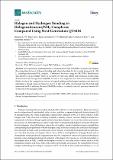Halogen and hydrogen bonding in halogenabenzene/NH3 complexes compared using next-generation QTAIM
Abstract
Next-generation quantum theory of atoms in molecules (QTAIM) was used to investigate the competition between hydrogen bonding and halogen bonding for the recently proposed (Y = Br, I, At)/halogenabenzene/NH3 complex. Differences between using the SR-ZORA Hamiltonian and effective core potentials (ECPs) to account for relativistic effects with increased atomic mass demonstrated that next-generation QTAIM is a much more responsive tool than conventional QTAIM. Subtle details of the competition between halogen bonding and hydrogen bonding were observed, indicating a mixed chemical character shown in the 3-D paths constructed from the bond-path framework set B. In addition, the use of SR-ZORA reduced or entirely removed spurious features of B on the site of the halogen atoms.
Citation
Li , S , Xu , T , van Mourik , T , Früchtl , H , Kirk , S R & Jenkins , S 2019 , ' Halogen and hydrogen bonding in halogenabenzene/NH 3 complexes compared using next-generation QTAIM ' , Molecules , vol. 24 , no. 16 , 2875 . https://doi.org/10.3390/molecules24162875
Publication
Molecules
Status
Peer reviewed
ISSN
1420-3049Type
Journal article
Description
This research was funded by the National Natural Science Foundation of China grant number: 21673071. The One Hundred Talents Foundation of Hunan Province is also gratefully acknowledged for their support of S.J. and S.R.K. The Royal Society is thanked by S.J., S.R.K, T.X, T.v.M and H.F. for support through an International Exchanges grant.Collections
Items in the St Andrews Research Repository are protected by copyright, with all rights reserved, unless otherwise indicated.

